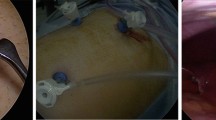Abstract
Background
Laparoscopic cholecystectomy has undergone many refinements including reductions in port size and number. This study attempts to determine whether further reduction in port size from that previously reported by us can reduce postoperative pain without compromising the efficacy of the surgery.
Methods
In this study, 159 patients underwent laparoscopic cholecystectomy with three ports: one 5-mm umbilical port, one 3-mm subxiphoid port, and one 3-mm port in the right subcostal position. Data were collected prospectively for each patient on the duration of analgesic use, quantity of analgesic tablets consumed, postoperative pain, most painful incision, and days of recovery required before return to activity and work. These measures were compared with those collected from a group of 100 patients who had undergone laparoscopic cholecystectomy with three 5-mm ports in a previous study.
Results
Patients in the current study group required analgesics for a longer duration (4 vs 2.9 days; p = 0.001), used more analgesic tablets (10.7 vs 8.1; p = 0.007), and reported greater postoperative discomfort (5 vs 4.1; p= 0.016) as compared with all in the 5-mm port group. The 3-mm port group needed more days for recovery before leaving the house (2.9 vs 2.7; p = 0.504), but they returned to work earlier (5.1 vs 5.9; p = 0.065) than the group that had undergone cholecystectomy with three 5-mm ports, although there was not a significant difference between the groups. Operative time increased from 18.5 to 20.9 min (p = 0.054) in the group with two 3-mm ports. Five patients (3.1%) in the current group required enlargement of a port to complete the procedure, as compared with none in the comparison group. There was one complication (0.6%), as compared with two complications (2.0%) in the previous group.
Conclusions
This study did not demonstrate a reduction in postoperative pain or a consistent improvement in recovery when the port size was reduced at the subcostal and subxiphoid positions. It did, however, show that ports could safely be reduced in size without a negative impact on the surgeon’s ability to perform a cholecystectomy. Reducing port size can be a tool in the surgeon’s armamentarium for use in the attempt to optimize cosmetic results.
Similar content being viewed by others
References
Cala Z (1994) Laparoscopic cholecystectomy using three trocars. Surg Endosc 8: 476
Cala Z (1996) To the editor. World J. Surg 20: 117–118
Golder M, Rhodes M (1998) Prospective randomized trial of 5-and 10-mm epigastric ports in laparoscopic cholecystectomy. Br J Surg 85: 1066–1067
Gorini P, Capizzi FD (1997) A three-trocar approach to laparoscopic removal of the gallbladder. Surg Laparosc Endosc 7: 180–181
Kimura T, Sakuramachi S, Yoshida M, Kobayashi T, Takeuchi (1998) Laparoscopic cholecystectomy using fine-caliber instruments. Surg Endosc 12: 283–286 DOI: 10.1007/s004649900654
Leggett PL, Churchman-Winn R, Miller G (2000) Minimizing ports to improve laparoscopic cholecystectomy. Surg Endosc 14: 32–36
Leung KF, Lee KW, Cheung TY, Leung LC, Lau KW (1996) Laparoscopic cholecystectomy: two-port technique. Endoscopy 28: 505–507
Mouret P (1996) How I developed laparoscopic cholecystectomy. Ann Acad Med Singapore 25: 744–747
Mühe E (1992) Long-term follow-up after laparoscopic cholecystectomy. Endoscopy 24: 754–758
Navarra G, Pozza E, Occhionorelli S, CarcoForo P, Donini I (1997) One-wound laparoscopic cholecystectomy. Br J Surg 84: 695
Reardon PR, Kamelgard JI, Applebaum B, Rossman L, Brunicardi FC (1999) Feasibility of laparoscopic cholecystectomy with miniaturized instrumentation in 50 consecutive cases. World J Surg 23: 128–131
Reddick EJ, Olsen DO (1989) Laparoscopic laser cholecystectomy: a comparison with mini-lap cholecystectomy. Surg Endosc 3: 131–133
Roll S, Azevedo JL, Gorski W, Abdalla R, Azevedo O (1997) Two-port technique for laparoscopic cholecystectomy using a microendo-scope. Endoscopy 29: S43
Slim K, Pezet D, Stencl J, Lechner C, Le Roux S, Lointier P, Chipponi J (1995) Laparosopic cholecystectomy: an original three-trocar technique. World J. Surg 19: 394–397
Tabet J, Anvari M (1999) Laparoscopic cholecystectomy for gallbladder dyskinesia: clinical outcome and patient satisfaction. Surg Laparosc Endosc Perc Technol 9: 382–386
Tagaya N, Kita J, Takagi K, Imada T, Ishikawa K, Kogure H, Ohyama O (1998) Experience with three-port laparoscopic cholecystectomy. J Hepatobiliary Pancreat Surg 5: 309–311
Author information
Authors and Affiliations
Rights and permissions
About this article
Cite this article
Leggett, P.L., Bissell, C.D., Churchman-Winn, R. et al. Three-port microlaparoscopic cholecystectomy in 159 patients. Surg Endosc 15, 293–296 (2001). https://doi.org/10.1007/s004640000302
Received:
Accepted:
Issue Date:
DOI: https://doi.org/10.1007/s004640000302




